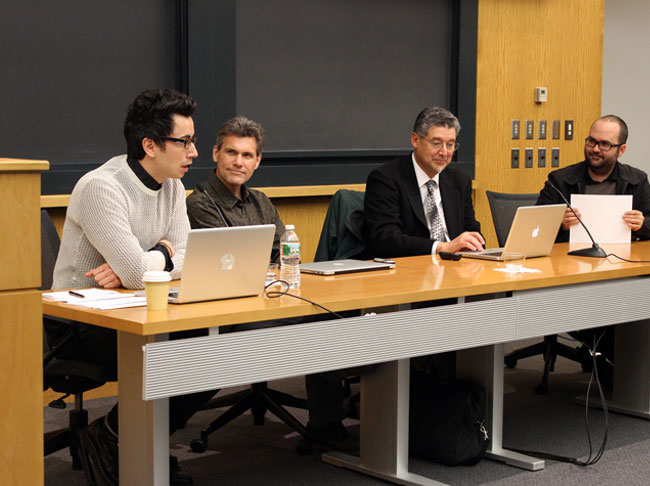An evening celebration and a panel discussion marked last week’s opening of David Taylor: Working the Line, a photography exhibition at the David Rockefeller Center for Latin American Studies. The exhibition, on view through May 9, includes a selection of the artist’s multiyear, two-part project focused on the US–Mexico border.
At the opening night celebration last Wednesday, David Taylor and exhibition curator Michelle Lamunière led the packed crowd through the exhibition, while the artist shared stories about his work. Taylor got the idea for the project from a chance encounter with Border Monument No. 6 on a remote dirt road. He told of the challenges of maneuvering through rough terrain and urban environments to photograph the 276 obelisk-shaped boundary monuments that make up the border between El Paso/Juarez and San Diego/Tijuana. He would regularly encounter and photograph the activities of Border Patrol agents, residents of both countries who lived along the border, and immigrants, smugglers, and drug traffickers who crossed the border. Over the six years that he was taking photographs, Taylor witnessed firsthand the growth of the US Border Patrol and the installation of fences and barriers.
The following evening, Taylor presented his work at the panel discussion Border Dynamics. Accompanying him were Professor Daniel Arreola, from Arizona State University, and photographer Alejandro Cartagena, who discussed their recent projects involving the border. Professor Sergio Delgado, Assistant Professor of Romance Languages and Literatures at Harvard University, served as moderator.
Arreola, who teaches in the School of Geographical Sciences and Urban Planning at ASU, Tempe, talked about his project Postcards from the Río Bravo Border, in which he connects hand-drawn fire insurance maps with 19th- and 20th-century photographic postcards to re-create a visual narrative of border towns in Mexico.
Cartagena, who lives and works in Monterrey, Mexico, documents people living in surrounding communities and how their identities are affected by the border. His recent work includes photographs of the children of Reynosa, a border town that has been overrun by drug cartels, and American-born Mexicans who have chosen to live in Mexico and are often harassed for that choice. He also depicts the effects of the recent housing bust, including mostly empty suburban developments, the car culture that has developed because of the distance of these developments to cities, and the carpooling habits of the residents. Cartagena recently received honorable mention for his work in the 2014 Leopold Godowsky, Jr. Color Photography Awards at Boston University’s Photographic Resource Center. His photographs are included in an exhibition there through March 22, 2014.
David Taylor: Working the Line is on view through May 9, 2014, at the David Rockefeller Center for Latin American Studies, Harvard University, 1730 Cambridge Street, 2nd floor, Cambridge, MA. Hours: Monday–Friday, 9am–5pm. Admission is free.
Some recent press on the exhibition:
Emma C. Cobb, “New Photography Exhibit Documents U.S.–Mexico Border,” Harvard Crimson, February 27, 2014.
Robyn Day, “Review: David Taylor: Working the Line,” Big Red & Shiny, March 11, 2014.
Mark Feeney, “David Taylor documents boundary between US, Mexico,” The Boston Globe, March 8, 2014.
Colleen Walsh, “Dots on the Borderline: Artist Photographs Monuments Marking where U.S. Ends, Mexico Begins,” Harvard Gazette, February 27, 2014.
Note: This story has been updated to reflect the fact that the exhibition closing date has changed from May 18 to May 9.




